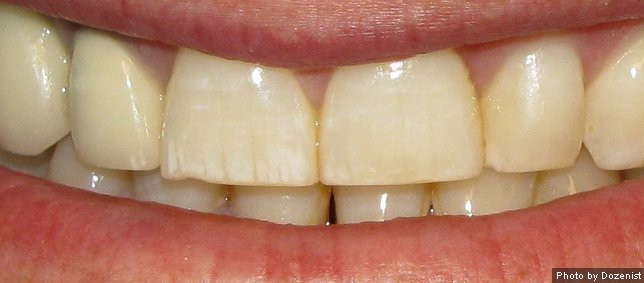Fluoride Yellow Teeth

The appearance of yellow teeth can be a source of concern for many individuals, affecting their self-confidence and overall oral health. One potential cause of yellow teeth is the excessive consumption of fluoride, particularly during childhood and adolescence. While fluoride is essential for the prevention of tooth decay and the promotion of oral health, an overexposure to this mineral can lead to a condition known as dental fluorosis.
Dental fluorosis is a cosmetic condition characterized by the discoloration of tooth enamel, resulting in white or yellowish spots, streaks, or patches on the teeth. In severe cases, it can cause the teeth to appear completely yellow or brown. The severity of dental fluorosis depends on the amount and duration of fluoride exposure, as well as the individual’s sensitivity to the mineral.
Research has shown that children who consume excessive amounts of fluoride between the ages of 1 and 4 are more likely to develop dental fluorosis. This is because their teeth are still developing, and the excessive fluoride can interfere with the formation of the enamel. Additionally, children who swallow toothpaste or mouthwash containing fluoride are at a higher risk of developing dental fluorosis.
However, it is essential to note that dental fluorosis is not the only cause of yellow teeth. Other factors, such as poor oral hygiene, smoking, and the consumption of certain foods and beverages, can also contribute to tooth discoloration. Furthermore, some medical conditions, such as jaundice or certain metabolic disorders, can cause yellowing of the teeth.
To address the issue of yellow teeth caused by fluoride, it is crucial to practice good oral hygiene habits, such as brushing and flossing regularly. Additionally, individuals who are concerned about dental fluorosis should consult with their dentist or healthcare provider to determine the best course of treatment. In some cases, professional teeth whitening or dental restorations may be necessary to improve the appearance of the teeth.
In recent years, there has been an ongoing debate about the optimal level of fluoride in community water systems. While some argue that fluoride is essential for the prevention of tooth decay, others claim that it can have negative health effects, such as dental fluorosis and thyroid problems. The American Dental Association (ADA) recommends that community water systems contain between 0.7 and 1.2 milligrams of fluoride per liter of water. However, some studies suggest that even at these levels, fluoride can still cause dental fluorosis and other health problems.
To reduce the risk of dental fluorosis and promote overall oral health, individuals can take several steps:
- Practice good oral hygiene habits: Brush and floss regularly to remove plaque and bacteria from the teeth.
- Use fluoride-free toothpaste and mouthwash: If concerned about dental fluorosis, consider using fluoride-free oral care products.
- Monitor fluoride intake: Be aware of the amount of fluoride in community water systems, toothpaste, and other oral care products.
- Consult with a dentist or healthcare provider: Regular check-ups can help identify any oral health issues, including dental fluorosis, and provide guidance on the best course of treatment.
In conclusion, while fluoride is essential for the prevention of tooth decay and the promotion of oral health, excessive consumption can lead to dental fluorosis and yellow teeth. By practicing good oral hygiene habits, monitoring fluoride intake, and consulting with a dentist or healthcare provider, individuals can minimize the risk of dental fluorosis and maintain a healthy, beautiful smile.
What is dental fluorosis, and how does it affect the teeth?
+Dental fluorosis is a cosmetic condition characterized by the discoloration of tooth enamel, resulting in white or yellowish spots, streaks, or patches on the teeth. In severe cases, it can cause the teeth to appear completely yellow or brown.
What are the causes of yellow teeth, and how can they be prevented?
+Yellow teeth can be caused by a variety of factors, including dental fluorosis, poor oral hygiene, smoking, and the consumption of certain foods and beverages. To prevent yellow teeth, individuals should practice good oral hygiene habits, monitor fluoride intake, and avoid consuming staining substances.
How can I reduce the risk of dental fluorosis and promote overall oral health?
+To reduce the risk of dental fluorosis and promote overall oral health, individuals can practice good oral hygiene habits, use fluoride-free toothpaste and mouthwash, monitor fluoride intake, and consult with a dentist or healthcare provider.

